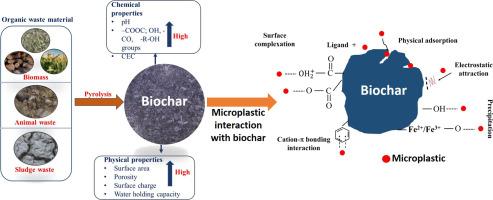Removal of micro- and nano-plastics from aqueous matrices using modified biochar – A review of synthesis, applications, interaction, and regeneration
IF 5.4
Q2 ENGINEERING, ENVIRONMENTAL
引用次数: 0
Abstract
The widespread contamination of aquatic environments by micro- and nano-plastics has become a global environmental concern that is demanding effective remediation strategies. The main objective of this paper is to find the application of modified biochar in micro- and nano-plastic removal from aqueous environments. In this paper, the synthesis of modified biochar, encompassing various modification techniques such as chemical functionalization, physical activation, and nanoparticle incorporation, is systematically explored. The intricate interaction mechanisms between modified biochar and microplastics are dissected by considering physical adsorption, chemical interactions, electrostatic forces, and hydrophobic interactions. The regeneration of biochar for repeated use is critically evaluated by emphasizing the challenges associated with structural changes and the loss of functional groups during regeneration processes. This review paper integrates findings from recent studies and identifies research gaps by offering insights into the optimization of biochar-based materials for sustainable and efficient removal of microplastics from aqueous matrices. It also guides future research endeavors and technological advancements in plastic pollution mitigation using sustainable materials.

利用改性生物炭去除水基质中的微塑料和纳米塑料--综述合成、应用、相互作用和再生
微塑料和纳米塑料对水生环境的广泛污染已成为一个全球环境问题,需要采取有效的补救策略。本文的主要目的是研究改性生物炭在去除水环境中的微塑料和纳米塑料方面的应用。本文系统地探讨了改性生物炭的合成,包括各种改性技术,如化学功能化、物理活化和纳米颗粒的加入。通过考虑物理吸附、化学作用、静电力和疏水作用,剖析了改性生物炭与微塑料之间错综复杂的相互作用机制。通过强调再生过程中与结构变化和功能基团损失相关的挑战,对生物炭的再生和重复使用进行了批判性评估。本综述论文整合了近期的研究成果,并通过深入分析生物炭基材料的优化问题,找出了研究空白,从而实现可持续、高效地去除水基中的微塑料。它还为未来利用可持续材料减轻塑料污染的研究工作和技术进步提供了指导。
本文章由计算机程序翻译,如有差异,请以英文原文为准。
求助全文
约1分钟内获得全文
求助全文
来源期刊

Journal of hazardous materials advances
Environmental Engineering
CiteScore
4.80
自引率
0.00%
发文量
0
审稿时长
50 days
 求助内容:
求助内容: 应助结果提醒方式:
应助结果提醒方式:


